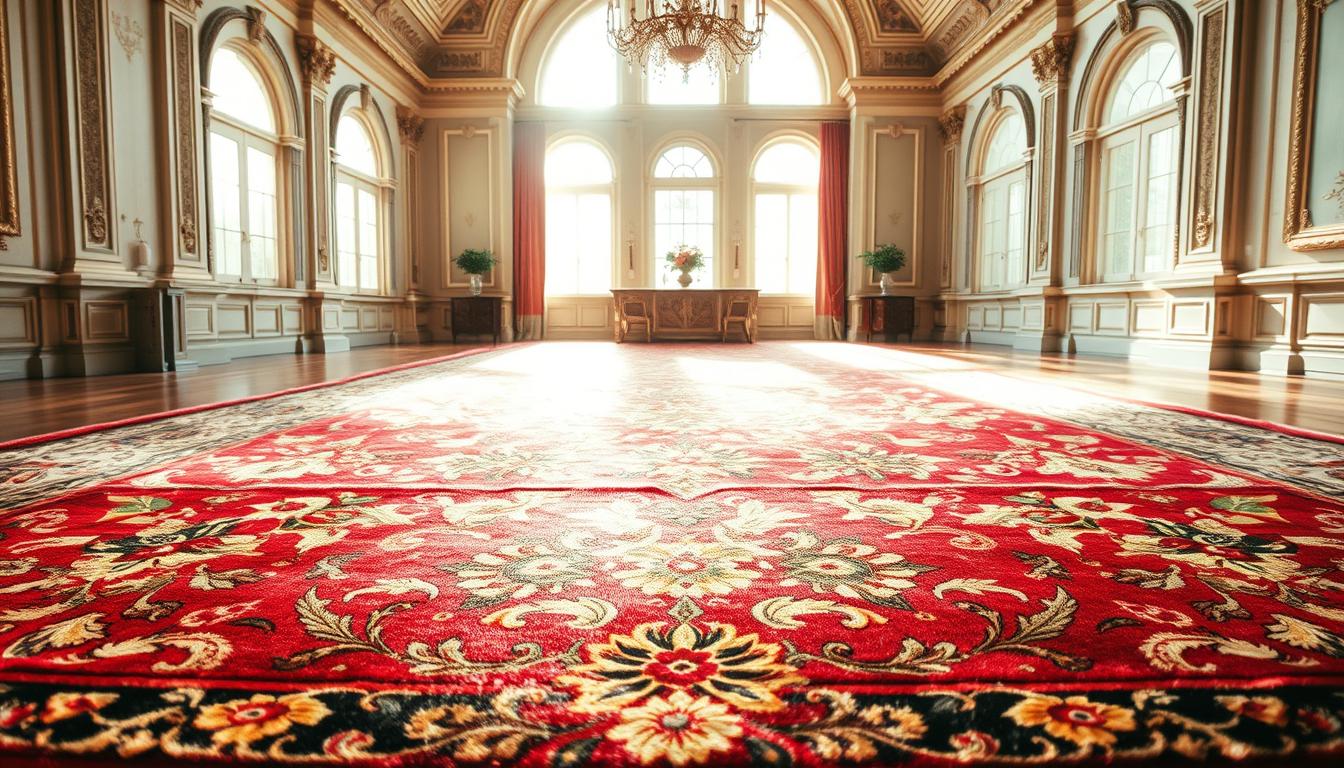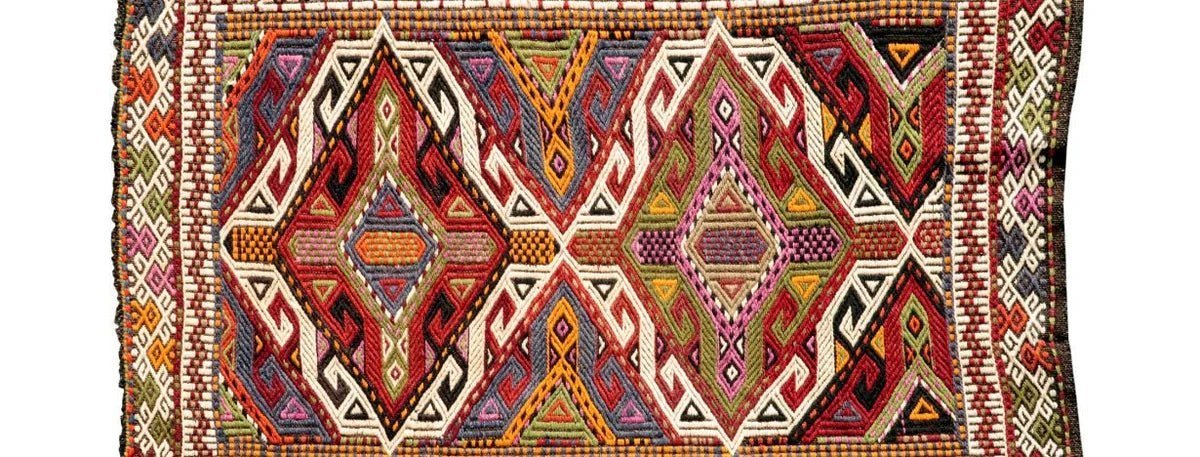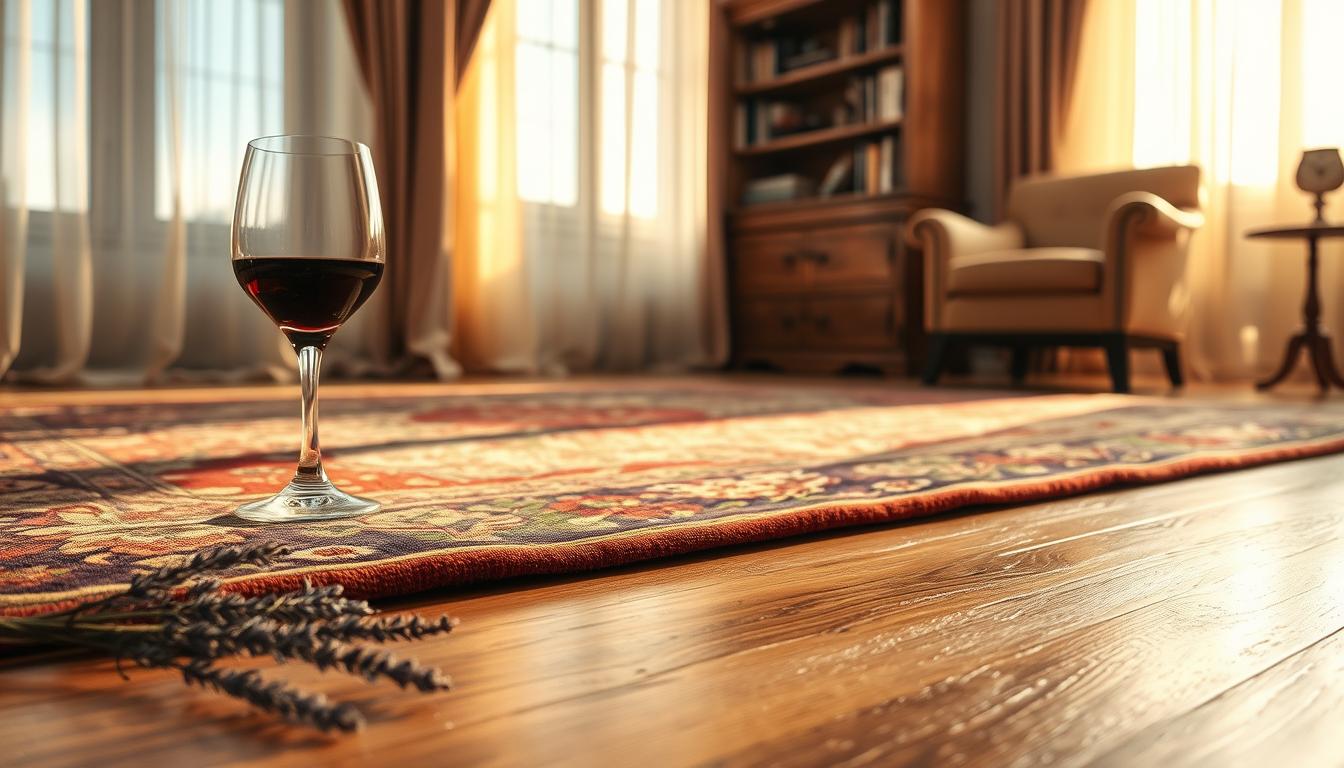
7 Luxurious Facts About Silk Rugs
Could a floor covering truly hold the artistic weight of a museum masterpiece while surviving daily life? The answer lies in a material that has captivated civilizations for millennia—woven into treasures that defy expectations.

Prized for their luminous sheen and intricate designs, these textile marvels blend strength with elegance. Unlike wool counterparts, their smooth fibers lack hidden "pockets," revealing dirt faster but dazzling eyes with light-reflecting depth. Each thread carries centuries of craftsmanship, transforming functional pieces into heirlooms that gain value like fine paintings.
You’ll uncover how artisans achieve astonishing densities of 1,200 knots per square inch—a feat requiring years of precision. Beyond aesthetics, discover why collectors view them as cultural time capsules, merging durability with storytelling brilliance.
Key Takeaways
- Silk fibers create unmatched luminosity, with light reflection enhancing design depth
- Higher maintenance needs compared to wool due to soil visibility
- Hand-knotted construction often involves months or years of skilled labor
- Investment potential through appreciation in value over decades
- Cultural significance embedded in patterns and weaving traditions
An Introduction to the World of Silk Rugs
Step into a realm where floors transform into galleries of woven light. These textile masterpieces demand more than casual admiration—they embody human ingenuity perfected over generations.
Discovering the Luxury and Craftsmanship
Imagine threading a needle with strands finer than hair. Artisans spend months—sometimes years—tying thousands of knots per square inch. Their hands dance across looms, translating visions into tactile legends.
Regional styles tell distinct stories. Persian creations weave epic tales through intricate designs of gardens and mythic heroes. Chinese versions balance symbolic creatures with geometric harmony. Turkish patterns burst with tulips and vines, celebrating nature’s rhythms.
History and Cultural Significance
Centuries ago, these works art traveled along spice routes, enchanting emperors and merchants. Royal courts flaunted them as power statements—a single piece could equal a noble’s yearly income.
Three factors cemented their legacy:
- Trade networks spreading techniques from Isfahan to Istanbul
- Patronage by dynasties wanting immortality through threads
- Silk’s unique ability to hold dyes without fading
Unlike wool rugs, silk’s luminous surface reveals every fingerprint. Yet collectors cherish this vulnerability—proof of their living connection to history’s grandest eras.
What is a silk rug?
Beneath your fingertips lies a world where biology meets artistry. The distinction between natural and synthetic fibers determines whether you're touching history or imitation.

Understanding Natural vs. Artificial Silk
Genuine silk boasts tensile strength surpassing steel threads of equal thickness. This organic marvel withstands decades of foot traffic while maintaining its luminous glow. Unlike artificial silk made from wood pulp cellulose, natural fibers bend without breaking—a critical advantage in high-use areas.
Run your hand across the surface. Authentic threads feel like cool liquid, while synthetic alternatives exhibit subtle rigidity. Over time, rayon-based imitations shed fibers, leaving faint dust trails beneath the weave.
The Role of Knot Count in Defining Quality
Knot density separates masterworks from mass-produced decor. Artisans tie over 500 knots per square inch in real silk rugs—some reaching 1,200 for museum-grade pieces. Higher counts allow intricate patterns that synthetic fibers can't replicate without fraying.
Three telltale signs reveal quality craftsmanship:
- Patterns appear three-dimensional under angled light
- Reverse-side designs mirror the front with razor-sharp clarity
- Edge seams show no loose threads or uneven tension
Collectors often use jewelers' loupes to inspect knotwork. This scrutiny separates heirloom investments from disposable decor, proving why natural fibers command prices rivaling fine art.
The Art of Handcrafted Silk Rugs
Imagine hands moving like clockwork, threading strands thinner than whispers into legends. This is where raw material becomes cultural legacy—a dance of patience and precision spanning generations.
Traditional Weaving Techniques
Artisans use vertical looms and double-knot methods to lock patterns into permanence. Silk’s tensile strength allows up to 1,500 knots per square inch—equivalent to threading 45 miles of thread for a 9x12-foot piece. Unlike tufted rugs, each knot is individually tied, cut, and tightened. One misplaced loop unravels hours of work.
Intricate Designs and Symbolic Motifs
Patterns breathe with intention. Persian medallions symbolize unity, while Chinese dragons guard against misfortune. Vines winding through Turkish pieces mirror life’s cyclical nature. These elements shine brighter under silk’s light-reflecting fibers, creating depth that synthetic imitations lack.
Regional styles emerge through color choices too. Crimson threads in Indian rugs signify prosperity, while azure blues in Caucasian works echo mountain skies. Every hue holds decades of dyeing expertise, preserved through silk’s natural stain resistance.
The Materials Behind Luxurious Silk Rugs
Every masterpiece begins with its bones—hidden threads that dictate destiny. The foundation materials determine whether your piece becomes a fleeting trend or a century-spanning legacy. Choices here impact flexibility, knot density, and how patterns age over decades.
Genuine Silk and Its Unique Properties
Genuine silk behaves unlike any other fiber. Its single-filament structure reflects light like liquid mercury, creating that signature glow. With tensile strength rivaling steel wire, these threads withstand intricate knotting without snapping—crucial for achieving 1,500 knots per square inch.
Three traits define premium quality:
- Natural stain resistance from sericin proteins
- Color retention outperforming wool by decades
- Flexibility preventing creases in folded storage
Comparing Foundations: Silk vs Wool vs Cotton
Persian artisans often choose silk foundations (warp/weft threads) for maximum precision. This allows tighter knots and sharper pattern edges. Cotton foundations, common in Kashmir pieces, support larger sizes but limit knot density. Blended options—like wool piles on silk bases—balance durability with detail.
Consider this: A silk-on-silk construction costs 40% more than cotton-based equivalents but gains value faster. As noted in mastering rug materials, foundation choices directly affect cleaning methods and lifespan. Wool foundations add warmth underfoot but lack silk’s resistance to humidity-induced warping.
Exploring Knot Count and Weave Density
Density defines destiny in the world of woven luxury. Those tiny intersections of thread determine whether a piece becomes pedestrian decor or a museum-worthy artifact.
How High Knot Density Enhances Detail
Every knots per square inch acts like a pixel in a digital image. At 300-600 knots, floral patterns gain clarity. Beyond 1,000, weavers achieve photorealistic precision—individual feathers on birds or strands in a sunset become visible.
Silk’s slim fibers enable this microscopic artistry. Compare that to wool’s 100-300 knots per square inch limit. Thicker strands simply can’t bend tightly enough without fraying. The result? Blurry edges on complex designs.
What Knot Count Means for Investment Value
Market prices triple when density crosses 800 knots per square inch. Why? A 9x12-foot rug at 1,500 knots contains over 16 million hand-tied loops. That’s 14 months of non-stop work for two artisans.
Three factors amplify value:
- Rarity: Less than 3% of weavers master ultra-high-density techniques
- Durability: Tight knots resist unraveling better than loose weaves
- Detail preservation: Intricate patterns stay crisp for centuries
Yet smart collectors balance knot count with other elements. A 600-knot piece with rare natural dye patterns often outpaces 1,200-knot generic designs at auctions. True worth emerges when technical mastery meets storytelling genius.
Identifying Authentic and Quality Silk Rugs
Unlock the secrets hidden in every thread before investing in these textile treasures. Counterfeits flood markets, but sharp eyes and hands can spot masterpieces.

Techniques for Testing Authenticity
Rub fibers between your palms for 10 seconds. Real silk warms instantly, while synthetic alternatives stay cool. For certainty, snip a single strand (from the fringe) and light it:
- Burning hair scent confirms natural fibers
- Chemical odor or melted plastic smell reveals fakes
Inspect the foundation. Tight weaves with 500+ knots per inch signal genuine silk rugs. Loose grids or uneven edges hint at rushed imitations.
Visual and Tactile Cues to Look For
Authentic pieces glow like moonlight on water—their luster comes from proteins, not chemical coatings. Run fingers against the pile:
- Short, dense fibers (⅛ inch) indicate hand-clipped precision
- Longer, uneven piles often mask cheaper materials
Check where fringe meets the body. Sewn-on edges betray artificial silk rugs, while integrated threads prove craftsmanship. Proper care methods outlined in our cleaning guide help maintain these details for generations.
Caring for Your Luxurious Silk Rug
Your heirloom textile demands thoughtful stewardship to maintain its luminous beauty. Proper protocols prevent premature wear while preserving the craftsmanship that makes these pieces irreplaceable.
Proper Cleaning and Maintenance Tips
Weekly vacuuming removes abrasive particles without harming delicate fibers. Always disable rotating brushes—their friction frays threads over time. Use suction-only attachments, moving parallel to the pile’s direction.
| Task | Correct Method | Risk if Ignored |
|---|---|---|
| Spill Response | Blot with damp microfiber | Stain migration |
| Sun Exposure | Rotate every 3 months | Color fading |
| Deep Cleaning | Professional every 18 months | Fiber degradation |
When to Seek Professional Care
Specialized services become essential for stubborn stains or persistent odors. Experts use pH-balanced solutions that stabilize dyes while extracting contaminants. Their industrial roller wringers remove 95% moisture within hours—critical for preventing mold in dense weaves.
Never attempt steam cleaning or harsh detergents. Unlike wool, these fibers lack natural oils to resist chemical damage. Trust certified technicians who understand silk’s unique needs—your textile’s longevity depends on it.
Incorporating Silk Rugs into Your Home Décor
Elevate your space by treating these textile treasures as functional art. Their luminous quality and intricate patterns demand strategic placement to maximize visual impact while preserving their delicate nature.
Creative Ways to Showcase Your Rug
Layer smaller pieces over neutral jute or sisal rugs for contrast. This protects fibers while adding depth to minimalist rooms. Use them as statement table runners during formal gatherings—their reflective surfaces enhance candlelit ambiance.
Rotate displays seasonally. Bright floral designs energize spring spaces, while rich jewel tones complement winter interiors. For high-traffic zones, consult our guide on professional cleaning costs to maintain vibrancy between rotations.
Wall Hanging Versus Floor Placement Strategies
Mounting preserves intricate details better than foot traffic. Use archival-quality rods that distribute weight evenly across the top edge. Ensure walls receive indirect light to prevent fading.
Floor displays work best in low-traffic seating areas. Pair with furniture having rounded legs to minimize snagging. Always use rug pads—they reduce slippage and absorb 30% more impact than bare floors.
FAQ
How can you tell if a rug is made with genuine silk?
Genuine silk reflects light uniquely, creating a soft, luminous sheen. Rub the fibers—real silk feels cool and smooth, while artificial alternatives like rayon or bamboo silk may feel synthetic. Check labels or ask for certification to confirm materials.
Why does knot count matter in Persian Oriental rugs?
Higher knot density (measured per square inch) allows artisans to weave intricate designs with precision. Persian rugs with 300+ knots per square inch often feature detailed floral or geometric motifs, enhancing their value as investment pieces.
Can artificial silk rugs mimic the look of real silk?
Yes, materials like mercerized cotton or synthetic fibers replicate silk’s sheen at a lower cost. However, they lack natural silk’s tensile strength and depth of color. Inspect labels to avoid misrepresentation.
How do you clean a handcrafted silk rug without damaging it?
Vacuum gently with a brushless attachment and blot spills immediately. Avoid harsh chemicals—professional rug cleaning services specializing in delicate textiles are recommended for deep stains or discoloration.
Are wool rugs more durable than silk ones?
Wool’s thicker fibers make it better suited for high-traffic areas, while silk’s delicate pile excels in low-traffic spaces. Many Persian Oriental rugs blend both materials, using silk for intricate details and wool for foundational strength.
What makes Hereke silk rugs unique?
Hereke rugs, originating from Turkey, use fine silk threads and cotton foundations to achieve extraordinary detail. Their knot density often exceeds 1,000 per square inch, creating museum-quality works of art with lasting cultural significance.
Should you hang silk rugs on walls or place them on floors?
Wall hanging preserves delicate pile from wear, ideal for showcasing artistry. For floor placement, choose low-traffic areas and use a non-slip pad. Rotate periodically to ensure even exposure to light and foot traffic.










Leave a comment
This site is protected by hCaptcha and the hCaptcha Privacy Policy and Terms of Service apply.